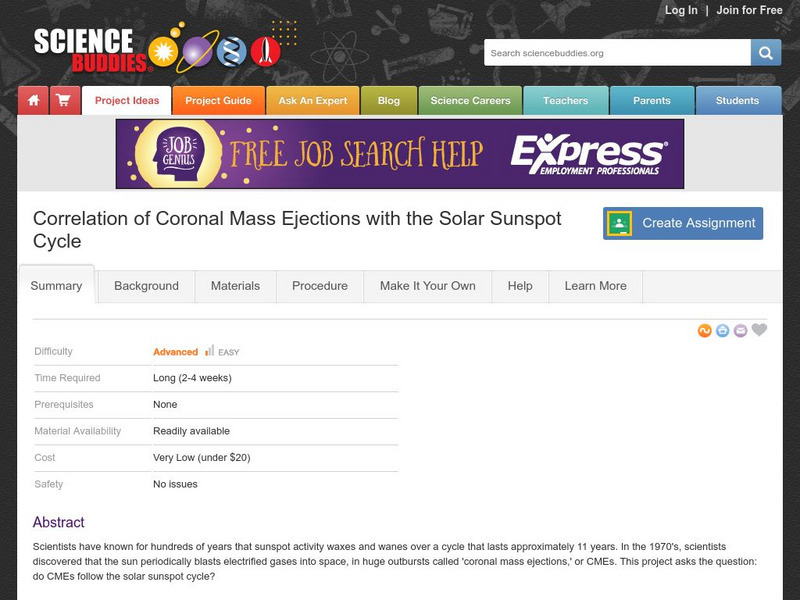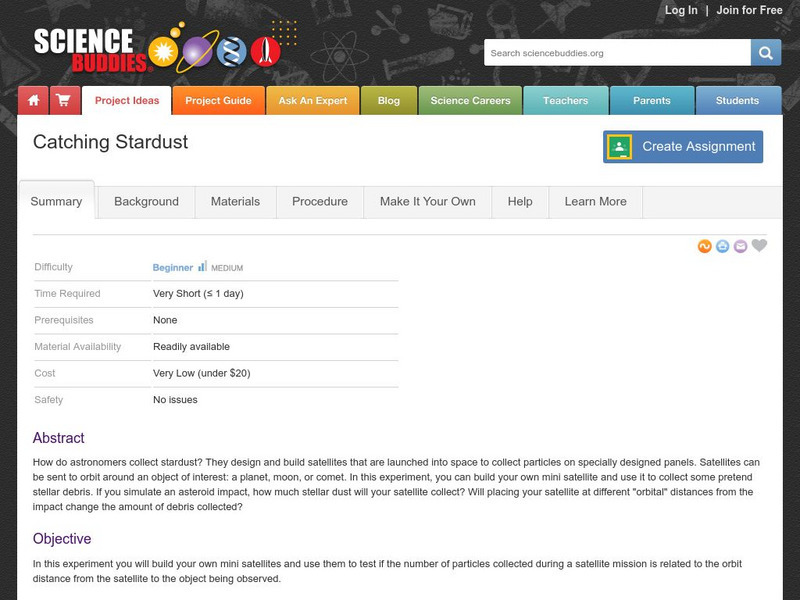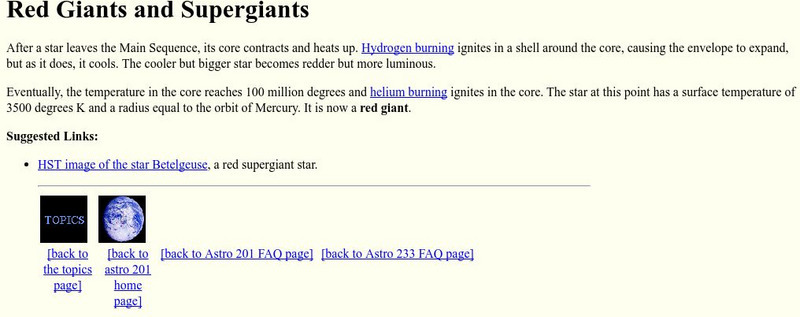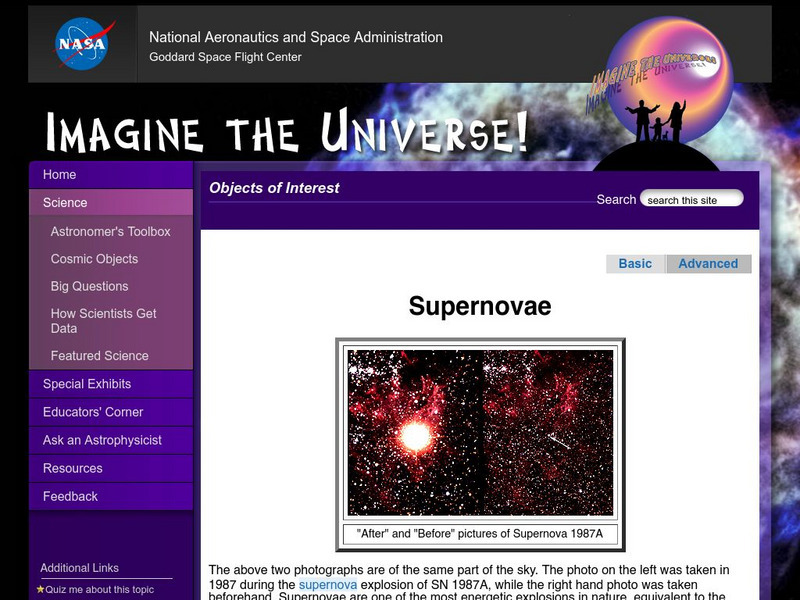University of Oregon
The Electronic Universe: Ccd Images of Planetary Nebulae
Basic characteristics of planetary nebulae and the relationship to stellar evolution is presented along with many detailed images.
Nine Planets
Nine Planets: The Web Nebulae
This site from Nine Planets provides introductory material about nebulae, information and images of several types of nebulae, information on Edwin Hubble, and additional related sites are provided.
Science Buddies
Science Buddies: Correlation of Coronal Mass Ejections With Solar Sunspot Cycle
Scientists have known for hundreds of years that sunspot activity waxes and wanes over a cycle that lasts approximately 11 years. In the 1970's, scientists discovered that the sun periodically blasts electrified gases into space, in huge...
Science Buddies
Science Buddies: Catching Stardust
How do astronomers collect stardust? They design and build satellites that are launched into space to collect particles on specially designed panels. Satellites can be sent to orbit around an object of interest: a planet, moon, or comet....
Cornell University
Cornell University: Astronomy: Red Giants
This Cornell University Astronomy Department site surveys the the hydrogen and helium burning that takes place in the evolution of a red giant. Links to related information.
American Association of Physics Teachers
Com Padre Digital Library: Open Source Physics: Remarkable Three Body Motions
What happens in space when a third celestial body joins two others? Discover both simple and complex situations which occur supporting Newtonian law in space with this collection of applets.
NASA
Nasa: For Educators
Contains many links to projects and workshops, as well as educational resources.
Harvard University
Chandra Special Features
Chandra allows astronomers to view our galaxy and beyond in ways only dreamt of before. 14 interactive features are offered in this exciting look at cosmic phenomena.
Discovery Education
Discovery Education: Lesson Plans Library K 5
This resource presents a lesson plan library which holds hundreds of lesson plans organized by grade level and subject area. Often rooted with an Internet research piece, each lesson plan contains specific objectives, procedures,...
Other
Nasa/msu Bozeman Center for Educational Resources (Ceres) Project
The CERES Project allows the nation's classroom teachers to develop "an extensive library of on-line and interactive K-12 science education materials for teaching astronomy." The site features latest news and photos from NASA,...
Harvard University
Smithsonian Astrophysical: Chandra X Ray Observatory
Chandra X-Ray Observatory is an space observatory designed to detect x-rays. The public web site gives information about Chandra and X-ray astronomy in general (in field guide). It also gives educational materials for teachers.
Other
Jodrell Bank Centre for Astrophysics: A Tutorial on Radio Pulsars
A extensive site that describes the history of the discovery of pulsars along with definitions, characteristics, locations, and distances of pulsars, plus much more.
University of Oregon
Stellar Evolution: White Dwarfs
Brief discussion of white dwarfs, their discovery, and evolution.
NASA
Nasa: Imagine the Universe: Fa Qs on Quasars
A list of answers to many questions related to quasars and active galaxies.
NASA
Nasa: Imagine the Universe: Supernovae (Basic)
A detailed description of a supernova developing from a single massive star. There is a quiz, related links, animation, lesson plans, and an FAQ sheet available also.
NASA
Nasa: Imagine the Universe: Supernovae (Advanced)
Supernovae are divided into two basic physical types, including a description of supernova types and how they are classified based on the existence of hydrogen spectral lines. Definitions of key terms are provided.
California Institute of Technology
Ipac at Cal Tech/what Are Supernovae?
Basic characteristics and definition, how astronomers study supernovae, the types of supernovae, where they occur, theories about supernovae, what supernovae tell us about the universe, and the effects of supernovae.
University of Chicago
Telescopes at Yerkes Observatory / Virtual Tour
This site describes the difference between reflective and refractive telescopes and includes a virtual tour of Yerkes Observatory which houses the largest refracting telescope in the world.
NASA
Nasa: Imagine the Universe: Supernovae Remnants
A brief description of supernova remnants with many embedded links to help define terms used in the description. The specific topics are age and the importance of remnants to us and the types. Definitions of key words are provided.
NASA
Nasa Star Child: Quasars (Level 2) Information
NASA presents the amount of energy, type of energy, brightness, and the detection of quasars. Provides several examples, pictures, and information.
California Institute of Technology
Cal Tech: Two Micron All Sky Survey
Learn about the Two Micron All Sky Survey project, in which telescopes and observatories scan the sky for infrared radiation in order to learn more about the Milky Way galaxy. The infrared spectrum is described and its importance to...
NASA
Electromagnetic Spectrum: Ultraviolet Waves
Ultraviolet (UV) light has shorter wavelengths than visible light. Though these waves are invisible to the human eye, some insects can see them. The specific wavelength values are given. Uses and applications of these waves are explained.
Cosmo Learning
Cosmo Learning: Modern Physics: Cosmology
A collection of video lectures from a cosmology course taught at Stanford University. The course gives an overview of the universe as a whole while focusing on astrophysics, physics, and astronomy in eight lectures. Lectures vary in length.
Other
Paper Plate Education: Serving the Universe on a Paper Plate
Excellent resource for "paper-plate" activities that help simplify various astronomy topics. Learn how to build a "Moon Finder" and "Planet Pointer," and create a paper-plate model that explains the Transit of Venus.
Other popular searches
- Astronomy and Space Science
- Space and Astronomy
- "Astronomy and Space Science
- Astronomy and Space Lesson


















